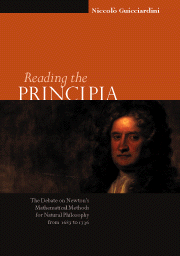 Reading the Principia
Reading the Principia Published online by Cambridge University Press: 29 March 2010
Purpose of this chapter
Section 2.2 is concerned with a mathematical method which Newton developed from the year 1664. He labelled it the ‘analytical method of fluxions’. It can be defined as the Newtonian equivalent, or counterpart, of the Leibnizian differential and integral calculus, and briefly – but somewhat improperly – called the ‘fluxional calculus’. From 1664 to the 1690s Newton elaborated several versions of it. Furthermore, Newton distinguished between an analytical and a synthetic method of fluxions (§2.3). In this chapter I will attempt a periodization of these versions, paying attention to concepts, rather than to results. What follows cannot be taken as an exposition or introduction to Newton's mathematical discoveries. This would take us too much space, and indeed, after Whiteside's works, would also be useless. What I will do rather is to sketch the nature of the mathematical method for drawing tangents and ‘squaring curves’ that Newton had developed before the composition of the Principia.
The analytical method
Mathematical background
Newton's interest in mathematics began around 1664 when he read François Viète's works (1646), the second Latin edition of René Descartes' Geometria (1659–61), William Oughtred's Clavis mathematicae (1631), and John Wallis's Arithmetica infinitorum (1656). It was in reading this selected group of works that Newton learned about the most exciting discoveries in analytical geometry, algebra, tangents, maxima and minima, quadratures, infinite series and infinite products.
To save this book to your Kindle, first ensure [email protected] is added to your Approved Personal Document E-mail List under your Personal Document Settings on the Manage Your Content and Devices page of your Amazon account. Then enter the ‘name’ part of your Kindle email address below. Find out more about saving to your Kindle.
Note you can select to save to either the @free.kindle.com or @kindle.com variations. ‘@free.kindle.com’ emails are free but can only be saved to your device when it is connected to wi-fi. ‘@kindle.com’ emails can be delivered even when you are not connected to wi-fi, but note that service fees apply.
Find out more about the Kindle Personal Document Service.
To save content items to your account, please confirm that you agree to abide by our usage policies. If this is the first time you use this feature, you will be asked to authorise Cambridge Core to connect with your account. Find out more about saving content to Dropbox.
To save content items to your account, please confirm that you agree to abide by our usage policies. If this is the first time you use this feature, you will be asked to authorise Cambridge Core to connect with your account. Find out more about saving content to Google Drive.